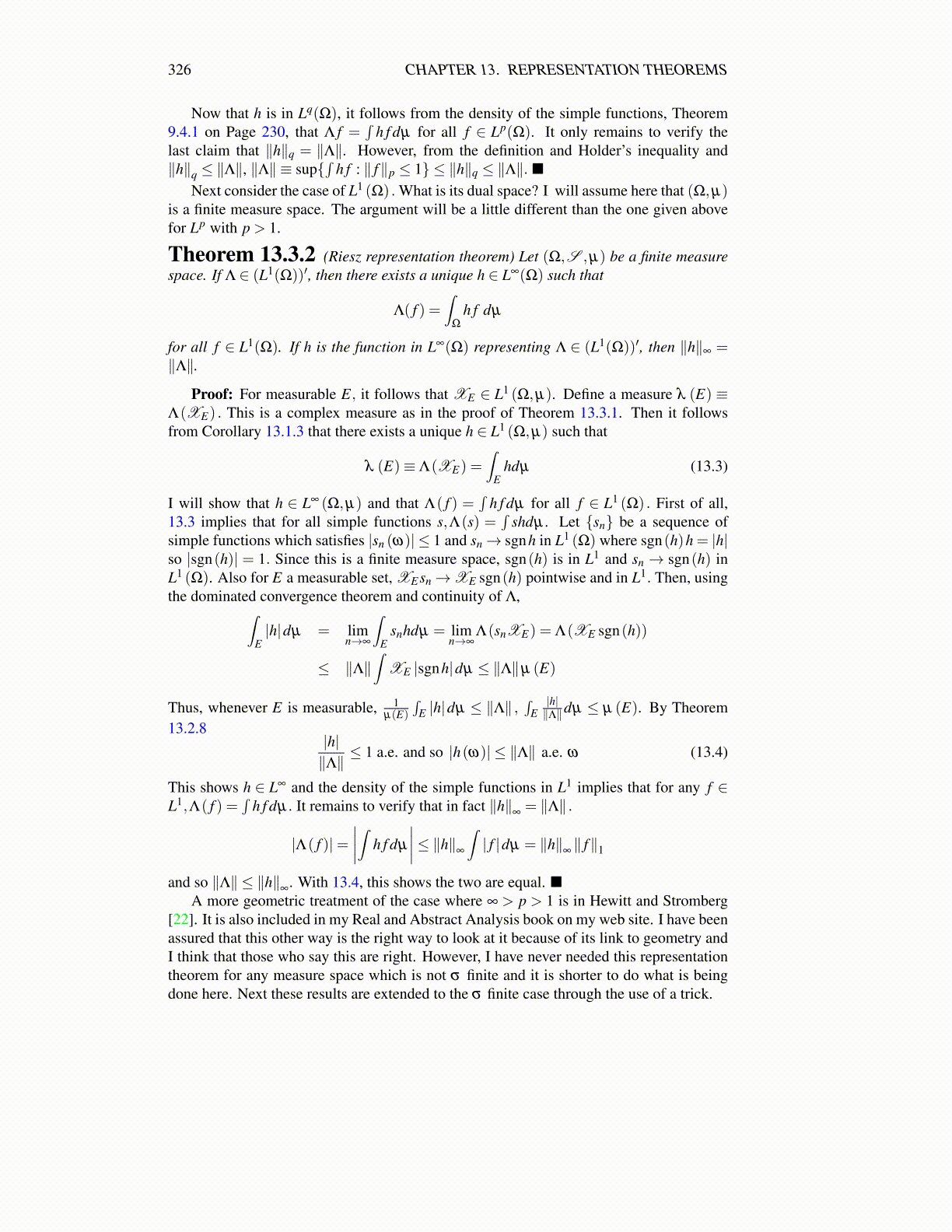
326 CHAPTER 13. REPRESENTATION THEOREMS
Now that h is in Lq(Ω), it follows from the density of the simple functions, Theorem9.4.1 on Page 230, that Λ f =
∫h f dµ for all f ∈ Lp(Ω). It only remains to verify the
last claim that ∥h∥q = ∥Λ∥. However, from the definition and Holder’s inequality and∥h∥q ≤ ∥Λ∥, ∥Λ∥ ≡ sup{
∫h f : ∥ f∥p ≤ 1} ≤ ∥h∥q ≤ ∥Λ∥. ■
Next consider the case of L1 (Ω) . What is its dual space? I will assume here that (Ω,µ)is a finite measure space. The argument will be a little different than the one given abovefor Lp with p > 1.
Theorem 13.3.2 (Riesz representation theorem) Let (Ω,S ,µ) be a finite measurespace. If Λ ∈ (L1(Ω))′, then there exists a unique h ∈ L∞(Ω) such that
Λ( f ) =∫
Ω
h f dµ
for all f ∈ L1(Ω). If h is the function in L∞(Ω) representing Λ ∈ (L1(Ω))′, then ∥h∥∞ =∥Λ∥.
Proof: For measurable E, it follows that XE ∈ L1 (Ω,µ). Define a measure λ (E) ≡Λ(XE) . This is a complex measure as in the proof of Theorem 13.3.1. Then it followsfrom Corollary 13.1.3 that there exists a unique h ∈ L1 (Ω,µ) such that
λ (E)≡ Λ(XE) =∫
Ehdµ (13.3)
I will show that h ∈ L∞ (Ω,µ) and that Λ( f ) =∫
h f dµ for all f ∈ L1 (Ω) . First of all,13.3 implies that for all simple functions s,Λ(s) =
∫shdµ . Let {sn} be a sequence of
simple functions which satisfies |sn (ω)| ≤ 1 and sn→ sgnh in L1 (Ω) where sgn(h)h = |h|so |sgn(h)| = 1. Since this is a finite measure space, sgn(h) is in L1 and sn → sgn(h) inL1 (Ω). Also for E a measurable set, XEsn→XE sgn(h) pointwise and in L1. Then, usingthe dominated convergence theorem and continuity of Λ,∫
E|h|dµ = lim
n→∞
∫E
snhdµ = limn→∞
Λ(snXE) = Λ(XE sgn(h))
≤ ∥Λ∥∫
XE |sgnh|dµ ≤ ∥Λ∥µ (E)
Thus, whenever E is measurable, 1µ(E)
∫E |h|dµ ≤ ∥Λ∥ ,
∫E|h|∥Λ∥dµ ≤ µ (E). By Theorem
13.2.8|h|∥Λ∥
≤ 1 a.e. and so |h(ω)| ≤ ∥Λ∥ a.e. ω (13.4)
This shows h ∈ L∞ and the density of the simple functions in L1 implies that for any f ∈L1,Λ( f ) =
∫h f dµ. It remains to verify that in fact ∥h∥
∞= ∥Λ∥ .
|Λ( f )|=∣∣∣∣∫ h f dµ
∣∣∣∣≤ ∥h∥∞
∫| f |dµ = ∥h∥
∞∥ f∥1
and so ∥Λ∥ ≤ ∥h∥∞
. With 13.4, this shows the two are equal. ■A more geometric treatment of the case where ∞ > p > 1 is in Hewitt and Stromberg
[22]. It is also included in my Real and Abstract Analysis book on my web site. I have beenassured that this other way is the right way to look at it because of its link to geometry andI think that those who say this are right. However, I have never needed this representationtheorem for any measure space which is not σ finite and it is shorter to do what is beingdone here. Next these results are extended to the σ finite case through the use of a trick.